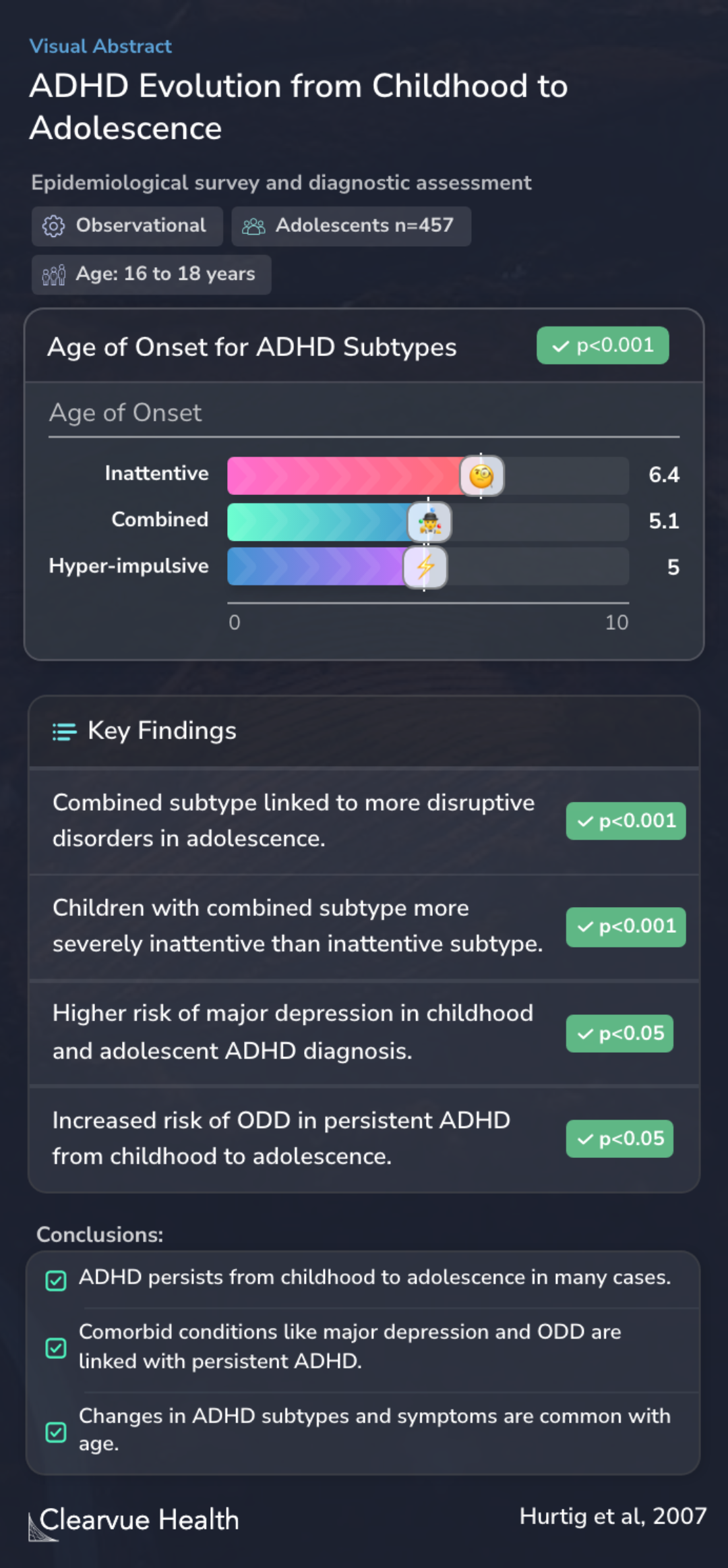ADHD symptoms and subtypes: relationship between childhood and adolescent symptoms
ADHD Evolution from Childhood to Adolescence
Hurtig T, Ebeling H, Taanila A, Miettunen J, Smalley SL, McGough JJ, Loo SK, Järvelin MR, Moilanen IK

Objectives
The study aimed to explore the symptoms and types of attention-deficit/hyperactivity disorder (ADHD) in young people during their childhood and teenage years. This research focused on understanding how ADHD presents itself at different ages and how these presentations might change over time.
To study attention-deficit/hyperactivity disorder (ADHD) symptoms and DSM-IV subtypes in childhood and adolescence.
Methods
In conducting their research, the authors surveyed 457 adolescents aged between 16 and 18 years, all part of the Northern Finland Birth Cohort 1986. This epidemiological study involved a detailed interview process to classify ADHD based on DSM-IV criteria. The study's approach was to retrospectively diagnose childhood ADHD and then explore how these symptoms and types evolved into adolescence, considering factors like behavior and family history of attentional problems.
A total of 457 adolescents ages 16 to 18 years from the Northern Finland Birth Cohort 1986 participated in an epidemiological survey for ADHD. After assessment with a diagnostic interview those with current or childhood ADHD were classified using DSM-IV criteria. Childhood diagnosis of A...
Results
The findings revealed that ADHD was more frequently reported during childhood than adolescence. Variations in how ADHD was categorized, or its subtype, were noted as children grew older. A significant observation was that individuals with a childhood and adolescent diagnosis of ADHD often had more pronounced inattentive symptoms. They also tended to have a higher incidence of major depression or oppositional defiant disorder (ODD) and were more likely to have fathers with attentional problems. This pattern differed from those who were only diagnosed with ADHD during childhood.
In terms of ADHD subtypes, the study found that the combined type was most common in childhood, while the inattentive type was more prevalent in adolescence.
Additionally, the age when ADHD symptoms first appeared differed among the subtypes. Children with the inattentive subtype generally showed symptoms at a later age compared to those with other subtypes.
Furthermore, the study highlighted that those with the combined subtype of ADHD in childhood were more prone to disruptive disorders in their teenage years. This group also showed more severe inattentive symptoms than their peers with the inattentive subtype of ADHD.
ADHD was reported more commonly in childhood than in adolescence and variations in subtype classification occurred. Those with childhood and adolescent diagnosis had endorsed specific inattentive symptoms more commonly, had greater comorbid major depression and/or oppositional defiant di...
Conclusions
The persistence of ADHD from childhood to adolescence may be common. Specific inattentive symptoms, certain psychiatric comorbidity, and family history of attention problems (fathers specifically) contribute to the risk of persistent ADHD. ADHD subtype differences reflect symptom severit...
Key Takeaways
Context
The study's findings align with previous research, such as the one conducted by Grizenko et al., which explored the differences between ADHD combined/hyperactive and inattentive subtypes. They found that the ADHD combined/hyperactive subtype was more associated with conduct disorder and had a better response to treatment.
The current study's results also resonate with broader research trends that examine the predictors of recovery from ADHD. It has been observed that ADHD patients with less severe symptoms and fewer additional mental health issues are more likely to recover by adulthood: